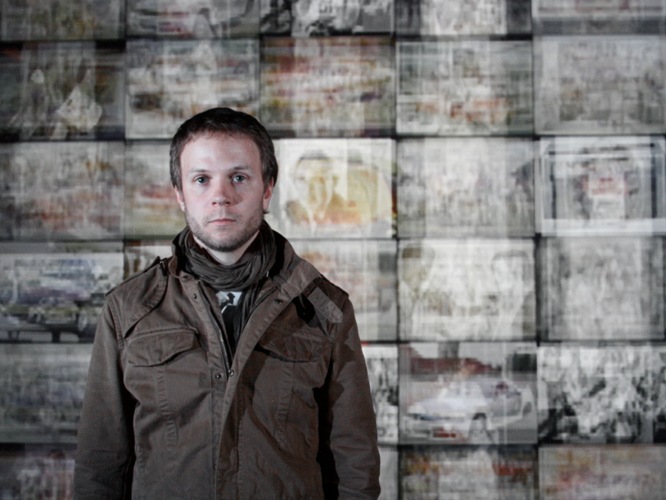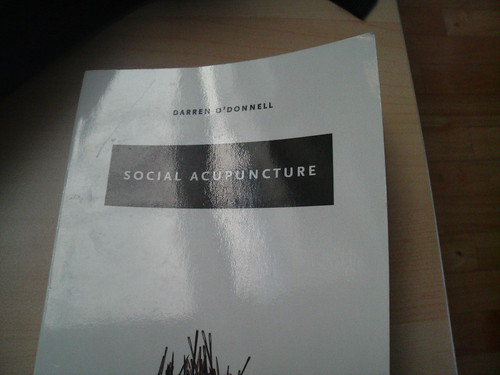How the media perpetuates a distance between news and our lives
In a highly digital society where information can be sent and received instantaneously it is amazing how much of the population is unaware of the worldwide events that are not happening in their immediate area. Since televisions invaded our homes in the twentieth century, visual representations of the news have become more prominent in society. Through the discourse of media, society finds themselves subject to censorship and a sense of passivity when dealing with the stories and images they are confronted with.
Upon stepping into the fictitious realm of photojournalist Thomas Smith, audiences of Photog entered an area of the media where the general public is not often welcome. Created by Vancouver’s Boca del Lupo theatre company, Photog made it’s world premiere at Toronto’s Harbourfront Centre World Stage between November 17-20. The play used real life stories and corresponding photographs belonging to four working photojournalists and in doing so, commented on the role that the public plays in the discourse of media. Through the use of explicit images and stories, along with the intermedial use of technology, Photog challenges accepted discourses of Western media.
Photog questions the discourse of media by removing the filter that is usually placed between the content and the audience. This filter allows those confronted with the material to absorb a version less intense than the actual event. For Thomas, his filter is his camera. The character often remarks how with his camera at his eye he is able to see the events around him as photo opportunities. Even when running to give a wounded man aid, he takes the opportunity to shoot the event. This filter allows him to remove himself from his surroundings for the sake of the media.
Similarly, Thomas also recounts a scenario when his outstretched hand made its way into the frame of his image, and how he suddenly felt more present in the location. He realizes at that point the danger he is in and for the first time he can remember, he stops taking pictures. For the character, he sees himself as having a duty to send back these images to the western world, but when he can see himself in the frame, his understanding of the situation is shaken. His role is both undermined and supported by the discourse of the media. In one respect the media claims to be searching for truth in all of its pursuits, while conversely, it filters its material for sensational and political reasons (among others).
Thomas also discusses the filtering of news content in the play. In order to best affect the audience, he directs his comments about ignorance towards the acts that are happening in war-torn areas across the world, while westerners go about their daily lives. In a scene dimly lit with that was clearly a set in the night, Thomas takes images of the audience as he recounts his story. His pictures appear on the large and omnipresent screen that hangs behind him. Suddenly, like the people of Liberia or Kabul, we are the subjects of his work. Snapshots of the audience begin to layer amongst images of human terror in other areas of the world, and the message of presence and accountability begins to ring clearer amongst those in attendance. Through this beautifully executed intermedial connection, audiences can understand how much their lives are related to those in troubled areas, but that we choose not to acknowledge it.
Later in the production a set of image slides are found in the apartment and are used to illustrate a story from the front line. Thomas recounts how hard it is for him to come home, that people don’t understand what he has been through and are unwilling to change their distanced ways to better inform themselves. He comments on this distance, and amongst the images of Darfur and the Ivory Coast audiences see shots of the theatre they are sitting in, the lobby that they entered, and the neighborhood they passed through. These peaceful images juxtaposed with the chaotic and sad photos from his travels once again challenges the media’s removed approach of transmitting stories and tie audiences into the chaos that happens hundreds of miles away. While the house of the theatre is black, audiences often believe they are safe from interaction and scrutiny, however, through this bold move the audience gains a greater involvement and understanding of their role in the media.
Within the discourse of the media, there is a boundary of what can and cannot be discussed through these public outlets. Traditionally the media represents scenarios and facts in order to better inform their audiences which are portrayed according to the political and social views of the area. Unfortunately, the passivity of society means that these news stories are often easily forgotten over the course of our everyday lives. By engaging passive audiences through traditional forms of media, Photog forces a different understanding of how media affects our lives, and sparks interest for a change in the accepted discourse of media in our society.
Photog challenged the discourse of media in a number of ways. By using Thomas’s camera to create a filter of his experiences, we see the parallels between ourselves and the way the media filters the content and our experiences of the news. In using the camera to capture life snapshots of the audience and juxtaposing them into a news image that would usually be hard to relate to, the production asks audiences to connect with the material. Lastly, comparing the calm and safe nature of our lives in comparison to those in the war torn areas of the world we are able to question our own passivity towards news stories and the media. In challenging the discourse of the media, Photog created a different sense of understanding amongst audience members and encouraged a discussion and reevaluation of the discourse itself.
Photog: an imaginary look at the uncompromising life of Thomas Smith had a short world premiere run at the Harbourfront Centre World Stage from November 17-20, 2010. Directed by Sherry Yoon and written and performed by Jay Dodge, the Boca del Lupo created play had no further scheduled tours or performances at this time.




